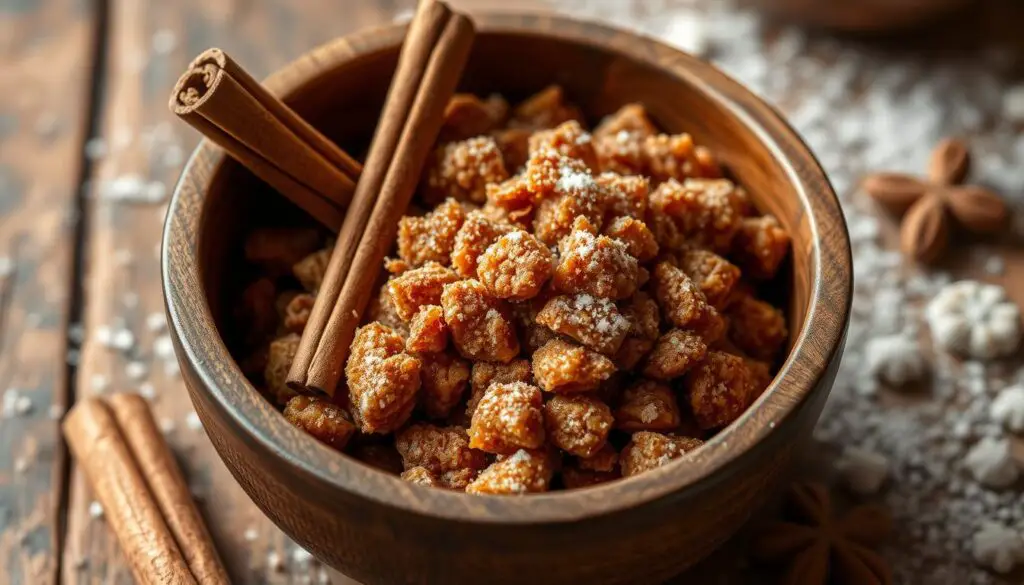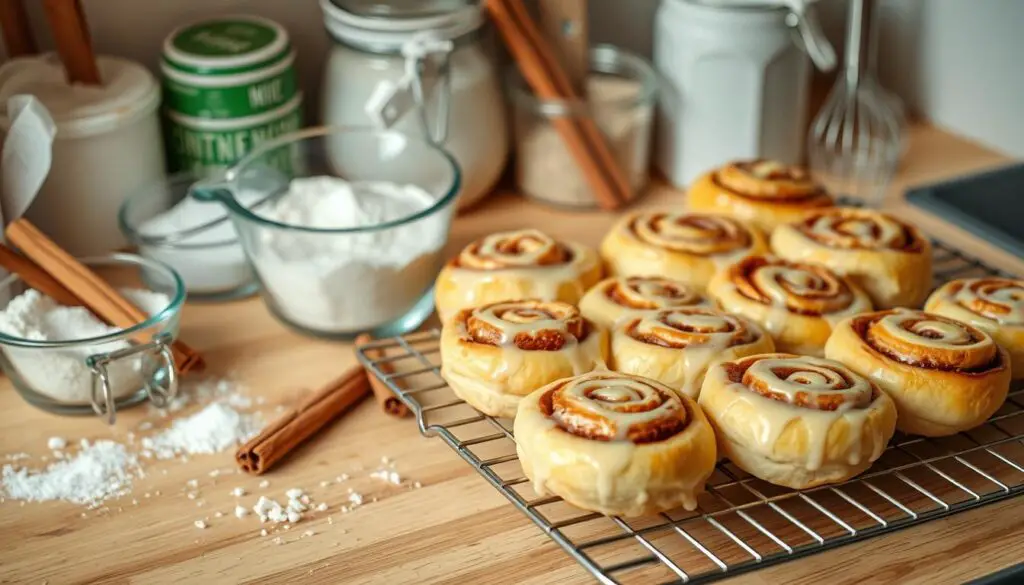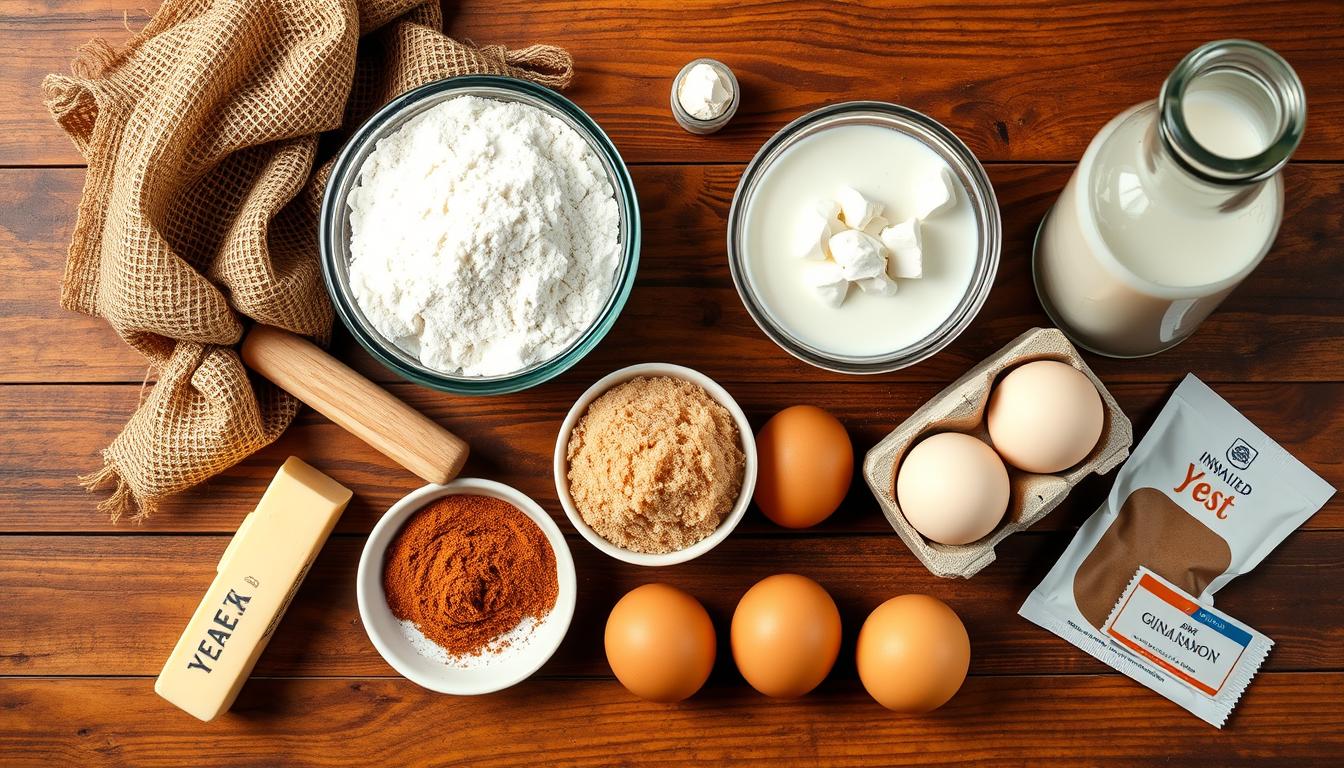Cinnamon rolls, a beloved pastry treasured worldwide, are a testament to the art of baking. These swirled delights, with their fragrant cinnamon filling and soft, pillowy dough, have captured the hearts and taste buds of countless individuals. In this comprehensive guide, we’ll explore the essential ingredients that make up the quintessential cinnamon roll, uncovering the secrets to crafting the perfect homemade batch.
Key Takeaways
- Discover the core ingredients that make up cinnamon rolls, including flour, sugar, yeast, and cinnamon.
- Understand the different types of cinnamon used in cinnamon rolls and their unique flavors.
- Learn the importance of butter in both the dough and the filling for achieving the perfect texture and taste.
- Explore the step-by-step process of preparing the dough and the cinnamon-sugar filling.
- Uncover the significance of icing and toppings in elevating the overall experience of cinnamon rolls.
Introduction to Cinnamon Rolls
Cinnamon rolls, a beloved pastry with a rich history, have become a staple in American cuisine. These delectable treats, also known as cinnamon buns or cinnamon swirls, are a classic pastry that have captivated the hearts and taste buds of sweet-lovers worldwide.
At their core, cinnamon rolls are made up of a soft, pillowy dough that is rolled out, coated with a fragrant cinnamon-sugar mixture, and then tightly wound into a spiral shape. Once baked, the result is a golden-brown, fragrant confection that oozes with a gooey, cinnamon-infused filling.
The origins of cinnamon rolls can be traced back to the sweets and pastries of ancient civilizations, where the combination of cinnamon and sweetness was highly prized. Over time, the recipe evolved, and cinnamon rolls became a beloved staple in European and American bakeries.
Today, cinnamon rolls remain a popular choice for breakfast, brunch, or as a comforting dessert. Their warm, cinnamony aroma and irresistible flavor have cemented their place as a cherished pastry in many households and culinary traditions.
“Cinnamon rolls are the edible embodiment of comfort and joy, a sweet embrace for the senses.”
In the following sections, we will delve deeper into the key ingredients, preparation techniques, and various types of cinnamon rolls, to help you create your own perfect batch of these beloved pastries.
Key Ingredients in Cinnamon Rolls
Crafting the perfect cinnamon rolls requires a careful selection of key ingredients. From the foundation of the dough to the spice that defines the flavor, each component plays a crucial role in creating a delightful and authentic treat. Let’s explore the essential elements that come together to make these beloved baked goods.
Flour: The Foundation of the Dough
The backbone of any cinnamon roll recipe is the dough, and the foundation of the dough is the flour. High-quality all-purpose flour or bread flour provides the structure and texture that allows the rolls to rise and achieve their signature soft, pillowy consistency. The right balance of gluten in the flour is essential for achieving the perfect chew and crumb.
Sugar: Adding Sweetness
Sugar is the ingredient that lends cinnamon rolls their alluring sweetness. Whether it’s white granulated sugar, brown sugar, or a combination of both, the sugar not only enhances the flavor but also helps to create the golden-brown caramelized crust that makes these rolls so irresistible. The right amount of sugar also plays a crucial role in activating the yeast and promoting a light, fluffy texture.
Yeast: The Secret to Fluffiness
The addition of yeast is the secret behind the fluffy, pillowy texture of cinnamon rolls. This leavening agent is responsible for creating the rise and airiness that sets these rolls apart from other baked goods. Active dry yeast or instant yeast can be used, and the proofing process is crucial for ensuring the dough reaches its full potential.
Cinnamon: The Star Spice
Of course, no cinnamon roll would be complete without the star ingredient: cinnamon. This warm, fragrant spice is the defining flavor that gives these rolls their iconic aroma and taste. The type of cinnamon used, whether it’s Ceylon or Cassia, can subtly influence the overall flavor profile.
“The secret to the best cinnamon rolls is in the careful selection and balance of the key ingredients. Each one plays a vital role in creating the perfect texture and flavor.”
Types of Cinnamon Used in Rolls
When it comes to baking cinnamon rolls, the type of cinnamon used can make all the difference. While cinnamon is a beloved spice, there are two main varieties that are commonly used: Ceylon cinnamon and Cassia cinnamon. Understanding the unique characteristics of each can help you choose the best cinnamon for your cinnamon rolls.
Ceylon Cinnamon: The True Cinnamon
Ceylon cinnamon, also known as “true cinnamon,” is prized for its delicate, sweet, and slightly floral flavor. This variety is grown primarily in Sri Lanka and is considered the most authentic and high-quality cinnamon. Its thin, brittle quills and light brown color distinguish it from its counterpart, Cassia cinnamon.
Cassia Cinnamon: The Common Choice
Cassia cinnamon, on the other hand, is the more commonly found and less expensive variety. Originating from China, Cassia cinnamon has a stronger, more intense flavor that is often described as woody or earthy. It is thicker and darker in color compared to Ceylon cinnamon, and it is the type of cinnamon most frequently used in baking with cinnamon.
When it comes to cinnamon varieties for cinnamon rolls, both Ceylon and Cassia can be used effectively. However, the choice often comes down to personal preference and the desired flavor profile. Ceylon cinnamon’s delicate sweetness may lend itself well to more traditional or delicate cinnamon roll recipes, while Cassia cinnamon’s bold flavor can stand up to richer, more indulgent variations.
Ultimately, the type of cinnamon you choose will depend on your personal taste and the specific recipe you’re following. Experimenting with both varieties can help you find the perfect cinnamon for your homemade cinnamon rolls.
The Role of Butter in Cinnamon Rolls
When it comes to baking the perfect cinnamon rolls, butter plays a crucial role. This rich and creamy ingredient contributes to the rich flavor and tender texture that make cinnamon rolls so irresistible. From the dough to the filling and even the frosting, butter is a versatile and essential component in crafting these beloved pastries.
In the dough, butter adds moisture and tenderness, helping to create a soft and pillowy base for the cinnamon rolls. The butter in baking also contributes to the overall texture of the final product, ensuring a delightful mouthfeel with each bite.
But butter’s impact doesn’t stop there. The rich flavor it imparts is also essential in the cinnamon-sugar filling, where it helps to create a luscious and gooey center. The butter melts and blends seamlessly with the cinnamon and sugar, resulting in a filling that truly sets cinnamon rolls apart from other pastries.
Finally, the creamy and indulgent frosting or glaze that tops off a freshly baked cinnamon roll would not be complete without the addition of butter. This final touch of butter in baking helps to tie all the flavors together, creating a harmonious and satisfying experience for the senses.
In short, butter is the unsung hero of cinnamon rolls, quietly yet profoundly shaping the rich flavor and tender texture that make these pastries so beloved. Whether in the dough, the filling, or the frosting, butter’s role is truly indispensable in crafting the perfect cinnamon roll.
How to Make the Perfect Dough
Crafting the perfect cinnamon roll dough is the foundation for creating mouthwatering, fluffy cinnamon rolls. From mixing the ingredients to mastering the kneading techniques, this section will guide you through the essential steps to achieve the ideal dough consistency.
Mixing Ingredients
Begin by combining the dry ingredients, including all-purpose flour, granulated sugar, and a pinch of salt, in a large mixing bowl. Activate the yeast by dissolving it in warm water or milk, then add it to the dry mixture. Gently incorporate the wet ingredients, such as melted butter and beaten eggs, until a shaggy dough forms.
Kneading Techniques
The key to developing the perfect cinnamon roll dough texture lies in the kneading process. Transfer the dough to a lightly floured surface and knead it for approximately 10 minutes, using the weight of your body to push and fold the dough. This action helps develop the gluten, creating a soft, elastic, and pliable dough that will rise beautifully.
“Proper kneading is the secret to achieving the ideal texture and rise in your cinnamon rolls.”
As you knead, be mindful of the dough’s consistency. It should be smooth, not too sticky, and slightly tacky to the touch. If the dough feels too dry, add a small amount of milk or water. Conversely, if it’s too wet, incorporate a bit more flour until the desired baking techniques are achieved.
With the right mixing and kneading techniques, you’ll be well on your way to crafting the most delectable and irresistible cinnamon rolls your family and friends have ever tasted.
Preparing the Cinnamon Filling
The cinnamon filling is the heart and soul of any delectable cinnamon roll. This rich, gooey layer is what sets these beloved pastries apart, infusing each bite with the warm, aromatic essence of cinnamon. Let’s explore the key elements that come together to create the perfect cinnamon sugar filling.
Cinnamon and Sugar Mixture
At the core of the cinnamon roll filling is a simple yet flavorful blend of ground cinnamon and granulated sugar. The ratio of these two ingredients is crucial, as it determines the balance of sweetness and spice. A classic cinnamon sugar filling typically uses a 1:4 ratio of cinnamon to sugar, resulting in a filling that is not overpowering, yet still bursting with cinnamon flavor.
Butter’s Importance in the Filling
While the cinnamon sugar mixture provides the primary flavor, the inclusion of butter is what gives the filling its signature gooey, spreadable texture. The butter acts as a binding agent, helping the cinnamon sugar mixture adhere to the dough and create those irresistible swirls and pockets of filling. The butter spread also contributes to the overall richness and indulgence of the cinnamon rolls.
Some bakers even opt to melt the butter before mixing it with the cinnamon sugar filling, ensuring a smooth, even distribution throughout the dough. This technique can enhance the flavors and create a more cohesive, decadent filling.

Variations on the classic cinnamon sugar filling can include the addition of chopped nuts, such as pecans or walnuts, for a delightful crunch, or a touch of vanilla extract to complement the warm spices. Experimentation with different spices, like nutmeg or cardamom, can also put a unique spin on the traditional filling.
The Significance of Icing and Toppings
Icing and toppings are the finishing touches that can elevate a simple cinnamon roll into a delightful culinary masterpiece. Whether you prefer the classic cream cheese frosting or a creative alternative, the right topping can truly enhance the flavors and textures of your homemade cinnamon rolls.
Cream Cheese Icing: A Classic Choice
The creamy, tangy goodness of cream cheese icing is a time-honored favorite when it comes to topping cinnamon rolls. The richness of the cream cheese perfectly complements the warmth and spice of the cinnamon, creating a harmonious balance of flavors. Spread generously over the freshly baked rolls, the cream cheese icing melts into the nooks and crannies, providing a luxurious and indulgent experience with every bite.
Alternatives: Glaze, Fondant, and Nuts
While the cream cheese icing is a classic, there are many other delectable options for topping your cinnamon roll frosting. A simple, sweet glaze made with powdered sugar and a touch of milk or cream can provide a delicate sheen and subtle sweetness. Fondant, with its smooth and velvety texture, can also be a unique and elegant choice, allowing you to create intricate designs and decorations. For a crunchy contrast, consider sprinkling chopped toppings like nuts, such as pecans or walnuts, over the top of your cinnamon rolls.
The choice of icing or topping ultimately comes down to personal preference and the desired flavor profile. Experiment with different variations to find the perfect complement to your homemade cinnamon rolls and delight your taste buds.
Variations of Cinnamon Roll Recipes
While the classic cinnamon roll is a beloved treat, there are many delicious variations that build upon the traditional recipe. From gooey, caramelized sticky buns to rich and indulgent chocolate cinnamon rolls, these unique twists on the classic offer a diverse array of flavors and textures to satisfy every craving.
Classic Cinnamon Rolls
The quintessential cinnamon roll features a soft, yeasted dough swirled with a warm, fragrant cinnamon-sugar filling and topped with a silky cream cheese icing. This timeless combination is a perennial favorite, perfect for weekend brunch or an afternoon snack.
Sticky Buns: A Delicious Twist
Sticky buns take the classic cinnamon roll and add a layer of gooey, caramelized topping. The dough is topped with a mixture of brown sugar, butter, and pecans or walnuts, creating a rich, sticky, and utterly indulgent treat. These decadent rolls are perfect for satisfying a sweet tooth.
Chocolate Cinnamon Rolls
For the chocolate lovers, chocolate cinnamon rolls offer a delectable fusion of flavors. The dough is swirled with a mixture of cinnamon, sugar, and melted chocolate, creating a rich, fudgy filling. These rolls are often topped with a chocolate glaze or drizzle, making them a truly indulgent and satisfying breakfast or dessert option.
These cinnamon roll variations and unique recipes showcase the versatility of this beloved pastry. Whether you prefer the classic version or are in the mood for a more decadent twist, there’s a cinnamon roll out there to suit every taste bud.
Tips for Perfecting Your Cinnamon Rolls
Achieving the perfect cinnamon roll is an art form, but with the right techniques, you can elevate your baking game and create mouthwatering treats that will impress your friends and family. From proofing the dough to baking to perfection, let’s explore the secrets to crafting baking tips for perfect cinnamon rolls.
Proofing for Perfect Rise
Proofing, or allowing the dough to rise, is a crucial step in creating light and fluffy cinnamon rolls. Make sure to let the dough rise in a warm, draft-free environment until it has doubled in size. This ensures the yeast has had time to work its magic, resulting in a pillowy-soft texture.
Baking Tips for Golden Brown Rolls
- Keep a close eye on the oven temperature – it should be set to the perfect baking temperature to achieve that signature golden-brown color.
- Brush the tops of the rolls with melted butter or egg wash before baking to enhance the color and shine.
- Rotate the baking pan halfway through the baking time to ensure even browning.
- Use a baking dish with tall sides to prevent the rolls from spreading and losing their shape.
By mastering the art of proofing and baking, you’ll be well on your way to creating perfect cinnamon rolls that are sure to delight your taste buds.

Conclusion: Enjoying Your Freshly Baked Cinnamon Rolls
As you’ve learned, creating homemade cinnamon rolls from scratch is a truly rewarding experience. From mastering the dough and crafting the perfect filling to topping it off with a delectable icing, each step in the process contributes to the ultimate baking success. The aroma of warm, gooey cinnamon rolls fresh from the oven is simply irresistible.
When you finally bite into your homemade creation, you’ll be rewarded with a burst of flavors that simply can’t be matched by store-bought options. The soft, pillowy texture and the harmonious blend of cinnamon, sugar, and butter will transport you to a realm of pure indulgence. Baking success has never tasted so good!
“There’s nothing quite like the satisfaction of enjoying a warm, freshly baked cinnamon roll that you’ve made with your own hands. It’s a true labor of love.”
So, don’t be afraid to roll up your sleeves and dive into the world of cinnamon roll baking. With the right tips and techniques, you’ll be crafting bakery-worthy treats in no time. Embrace the process, savor each bite, and share the joy of your homemade cinnamon rolls with family and friends. Baking success is within your reach!
Frequently Asked Questions About Cinnamon Rolls
When it comes to making delectable cinnamon rolls, there are often a few common questions that arise. From troubleshooting dough issues to achieving the perfect texture, we’ve got you covered. Let’s dive into the most frequently asked questions about cinnamon rolls and provide you with concise, helpful answers.
One of the most common inquiries is, “How do I prevent my cinnamon rolls from becoming dense or tough?” The key lies in the kneading process. Be sure to knead the dough thoroughly, allowing the gluten to develop and create a soft, pillowy texture. Overworking the dough can lead to a dense result, so aim for a smooth, elastic consistency.
Another frequent question is, “How can I achieve that gooey, cinnamon-y center?” The secret is in the filling. Make sure to generously spread the cinnamon-sugar mixture over the dough before rolling it up. Additionally, consider adding a touch of butter to the filling to enhance the overall richness and flavor.
Lastly, many bakers wonder, “How long can I store leftover cinnamon rolls?” To ensure freshness, it’s best to store any uneaten rolls in an airtight container at room temperature for up to 3 days. If you’d like to extend their shelf life, you can refrigerate them for up to 1 week or freeze them for up to 2 months. Just be sure to reheat them before serving to restore their warm, irresistible texture.
